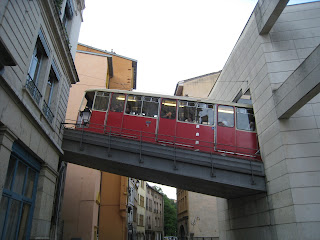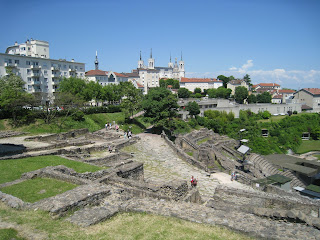When I came here with Natalia in June 2008 we stayed in a hostel marked by the "1" on the map. It had impressive views but was also perfectly situated for us to check out Vieux Lyon, both the upper and the lower parts. Here's a shot spanning over the old town and the vast array of buildings and spectacular collection of chimneys, with the Saône and the Presqu'île in the background:
The two lines in the shape of a "V" on the map above are the funicular lines since it's quite a steep hill. These funiculars opened in the late 1800s, but there were others built in Croix-Rousse as well, one of which was converted into the metro line C in the late 1970s. The pictures below show what it looks like on the ground level coming out of the Vieux Lyon metro station:
You'll also notice some streets in the area are called montées since it is very much an ascent to get up them. There are also lots of stairs for pedestrians or piétons. You certainly get your exercise when walking around this part of town!
Meandering through the cobblestone streets you truly feel like you have gone back a few hundred years (minus the tourists) as some buildings date back to the 15th and 16th centuries. Another special treasure in this part of the city, as well as in Croix-Rousse, are the traboules. In a very truncated explanation, these are passageways constructed through buildings to allow for easier access to the river and the streets parallel to it, but you can learn a bit more about them here: http://en.wikipedia.org/wiki/Traboule.
In general the architecture here is just really pleasing to look at. Many of the buildings are a pinky-orange colour and even if it's tourist-heavy area it's still enchanting to stroll around the streets full of terrasses (patios) for the endless selection of restaurants.
While the buildings in the lower part of the town are striking, there is far more ancient history to be found in the upper part near la Fourvière. Founded in 43 BC and named Lugdunum, it was the capital of Gaul and second in importance only to Rome for hundreds of years in the Roman Empire. (Mom and Dad - your expertise will be tested when you come to visit!)
There is a museum nearby called Musée gallo-romain de Lyon-Fourvière which we have yet to check out but we have walked around the two outdoor Roman amphitheatres and surrounding ruins. Quite deservedly this area is a UNESCO World Heritage Site. Check out their site for Lyon here: http://whc.unesco.org/en/list/872.
The last shot is of la Fourvière from the front. While you can see the church from many parts of downtown, you really have to go up to see it in person. It's such an icon for the city, one of the funiculars goes directly to it and it's free to enter both the basilica and the crypt. A must when visiting Lyon.
We were fortunate enough to watch a Rufus Wainwright concert in one of the amphitheatres last week, essentially the highlight of my life. It was part of Les Nuits de Fourvière, a summer festival held every June and July for over 60 years supporting the arts. I'd seen Rufus three times prior to this in Toronto, once doing a solo show and twice with a band. He was performing solo again and as usual it was phenomenal. For those of you who do not know Rufus' music, please get acquainted with it. It may not be for everyone, but he is superbly talented and most definitely worth a listen.
He sang several songs in French and spoke in French as well which was great. Proudly I knew all but three songs that he sang during the two hours we were there (he has seven albums which I know by heart). The first unknown was written by his aunt Anna McGarrigle, "Excursion à Venise" and the second was by his late mother Kate McGarrigle, "Entre Lajeunesse et la sagesse". In a move guaranteed to engage the audience even more he sang a Serge Gainsbourg song as part of his encore, "Je suis venu te dire que je m'en vais". Luckily I found the clip of him singing it at our concert on YouTube! Oh internet, thank you. Here for your listening pleasure: http://www.youtube.com/watch?v=pKLyHhd5MjY.
(Just to note - as one can imagine, sitting on ancient stones is not the most comfortable, so the festival provided everyone with a little plastic seat cushion, and at the end of the show everyone threw them up in he air and towards the stage in a gesture of appreciation amid applause and cheers.)
Aside from the highlight of his voice, the sunset was incredible and was actually paired with an immense lightning storm striking all over the city behind the stage to the east. It was truly breathtaking (literally - you could hear gasps from the audience during the songs because it was so intense). We barely had any actual rain come down, so it just added to the overall splendour of the show. It's going to be hard to top that performance...



























No comments:
Post a Comment